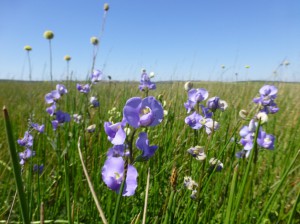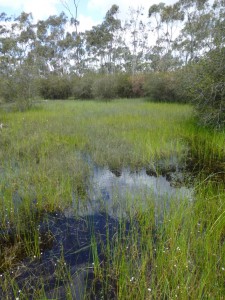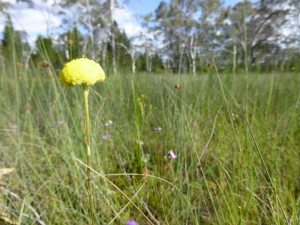
Seasonal Herbaceous Wetlands – Puddles in your Paddock
The Seasonal Herbaceous Wetlands (Freshwater) of the Temperate Lowland Plains ecological community was listed as critically endangered under national Australian environmental legislation in 2012. In 2013, Nature Glenelg Trust refined the mapping and the ecological description of this ecological community in South Australia for Natural Resources South East (DEWNR).
Seasonal Herbaceous Wetlands (SHW) occur across south eastern Australia from South East South Australia, through Victoria and just into southern New South Wales. However, there are very few SHWs that remain in good condition across their range, which is why they are listed as critically endangered. Seasonal Herbaceous Wetlands are usually very small, often less than one hectare, shallow and seasonal by nature – generally filling in winter, but dry by summer. These seasonal characteristics often lead people to refer to them as ‘puddles in their paddocks’. SHWs have a clay base, very low tree cover (<10%), are filled by local runoff and very fresh (generally less than 1000µS/cm).
Seasonal Herbaceous Wetlands are characterised by diversity of herbs and grasses, with a lower proportion of sedges/rushes. They are particularly beautiful in spring, when the wildflowers bloom with yellow, purple and white flowers. In summer when the wetland is dry, it returns to looking like part of the surrounding pasture or woodland, with a much higher dominance of grasses. The rare nature of the wetland type means that they often support of a number of threatened plants species that are restricted to seasonally inundated areas. They are also important habitat for a variety of frogs, birds and interesting invertebrates, like shield shrimp, fairy shrimp and dragonflies.
During the South Australian survey, NGT visited and assessed 174 wetlands, of which 95 sites confirmed as Seasonal Herbaceous Wetlands. The 95 sites in SA cover only 563.12 ha, demonstrating just how small these wetlands normally are. A majority of the Seasonal Herbaceous Wetlands (54) assessed in SA qualify for consideration as high value sites, containing more than three plants species that are sensitive to disturbance.
The Seasonal Herbaceous Wetlands occurred across a number of land-uses, including in conservation areas, forestry plantations and grazing properties. Wetlands that had only been lightly grazed or were relatively undisturbed still kept most of their characteristics, including wildflowers.
If you would like to find out more about these wetlands in South Australia, you can access the NGT report “Survey and description of the Seasonal Herbaceous Wetlands (Freshwater) of the Temperate Lowland Plains in the South East of South Australia” by clicking on the link.
Natural Resources South East currently have a program to care for these wetlands in South Australia and will be working again with NGT to assess more sites in late spring 2014. If you think you might have one or more on your SA property and would like to know more about it, please contact Steve Clarke (Wetland Conservation Ecologist, Natural Resources South East) on 08 8735 1177 or email by clicking here.
If you would like to see the conservation listing and conservation advice for Seasonal Herbaceous Wetlands click here to go to the Australian Government Department of the Environment site.



